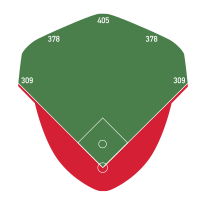
Back Memorial Stadium (parke sa Tinipong Bansa, Maryland) CEB Memorial Stadium (Baltimore) German Memorial Stadium (Baltimore) French メモリアル・スタジアム (ボルチモア) Japanese 메모리얼 스타디움 (볼티모어) Korean Memorial Stadium (Baltimore) Portuguese Memorial Stadium (Baltimore) SIMPLE
"The Old Grey Lady of 33rd Street" | |
 Memorial Stadium in 2000 | |
 | |
| Address | 900 East 33rd Street |
|---|---|
| Location | Baltimore, Maryland |
| Coordinates | 39°19′46″N 76°36′5″W / 39.32944°N 76.60139°W |
| Owner | City of Baltimore |
| Operator | Maryland Stadium Authority |
| Capacity | 31,000 (1950) 47,855 (1953) 53,371 (1991) |
| Field size | Left Field – 309 ft Left-Center – 446 ft (1954), 378 ft (1990) Center Field – 445 ft (1954), 405 ft (1980) Right-Center – 446 ft (1954), 378 ft (1990) Right Field – 309 ft  |
| Surface | Grass |
| Construction | |
| Broke ground | 1921 (first version) 1949 (second version) |
| Opened | December 2, 1922 (first version) April 20, 1950 (second version) |
| Closed | December 14, 1997 |
| Demolished | April 2001–February 15, 2002[1] |
| Construction cost | US$6.5 million ($82.3 million in 2023 dollars[2]) |
| Architect | Hall, Border, and Donaldson[3] |
| Structural engineer | R. E. L. Williams (building construction), Faisant and Kooken (consulting)[4] |
| General contractor | DeLucca-Davis & Carozza/Joseph F. Hughes[5] |
| Tenants | |
Baltimore Orioles (IL) mid-season 1944–1953
Baltimore Colts (AAFC / NFL) 1947–1950
Baltimore Comets (NASL) 1974–1975 | |
Baltimore Memorial Stadium was a multi-purpose stadium in Baltimore, Maryland, United States, that formerly stood on 33rd Street on an oversized block officially called Venable Park, a former city park from the 1920s. The site was bound by Ellerslie Avenue to the west, 36th Street to the north, and Ednor Road to the east.
Two stadiums were located here — a 1922 version known primarily as Baltimore Stadium or Municipal Stadium; and a rebuilt, double-deck, multi-sport stadium, completed in mid-1954, and rechristened Baltimore Memorial Stadium — Memorial Stadium for short.
- ^ "Memorial Stadium". MDStad.com. Maryland Stadium Authority. Retrieved January 21, 2024.
- ^ 1634–1699: McCusker, J. J. (1997). How Much Is That in Real Money? A Historical Price Index for Use as a Deflator of Money Values in the Economy of the United States: Addenda et Corrigenda (PDF). American Antiquarian Society. 1700–1799: McCusker, J. J. (1992). How Much Is That in Real Money? A Historical Price Index for Use as a Deflator of Money Values in the Economy of the United States (PDF). American Antiquarian Society. 1800–present: Federal Reserve Bank of Minneapolis. "Consumer Price Index (estimate) 1800–". Retrieved February 29, 2024.
- ^ Eggener, Keith. "The Demolition and Afterlife of Baltimore Memorial Stadium," Places Journal, October 2012. Retrieved October 9, 2022.
- ^ "J. L. Faisant Dies at 60," The Baltimore Sun, Monday, February 5, 1962. Retrieved October 9, 2022.
- ^ "Memorial Stadium". Ballparks.com. Retrieved March 1, 2012.